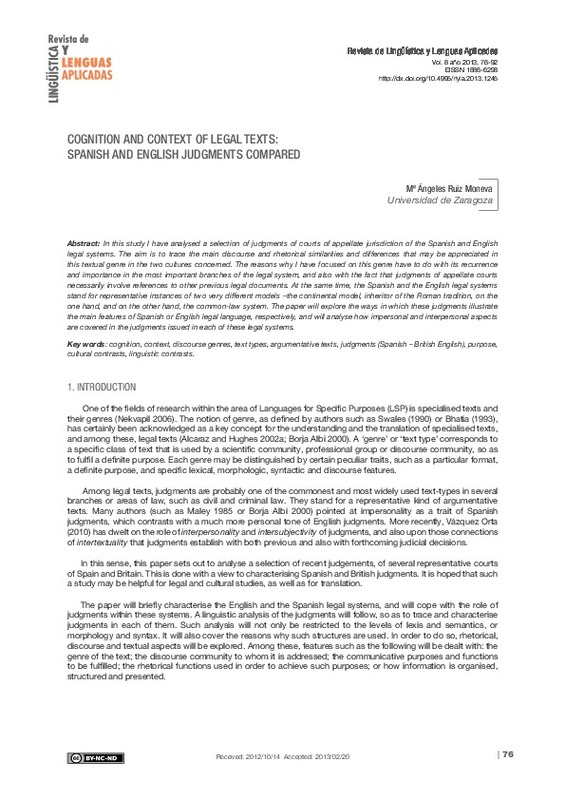A) Internet sites of the judgments consulted
BAILII: British and Irish Legal Information Institute: http://www.bailii.org [Last accessed: 04.10.2012]
Buscador de Jurisprudencia: Consejo General del Poder Judicial: CENDOJ: http://www.poderjudicial.es/search/indexAN.jsp [Last accessed: 04.10.2012]
[+]
A) Internet sites of the judgments consulted
BAILII: British and Irish Legal Information Institute: http://www.bailii.org [Last accessed: 04.10.2012]
Buscador de Jurisprudencia: Consejo General del Poder Judicial: CENDOJ: http://www.poderjudicial.es/search/indexAN.jsp [Last accessed: 04.10.2012]
B) Bibliographic references consulted
Alcaraz Varó, E. 2001 (1994). El inglés jurídico. Madrid: Ariel Derecho (5ª ed.).
Alcaraz Varó, E. and B. Hughes (2002a). Legal Translation Explained. Manchester: St. Jerome.
Alcaraz Varó, E. and B. Hughes (2002b). El español jurídico. Barcelona: Ariel Derecho.
Alcaraz Varó, E. and B. Hughes 2007 (1993). Diccionario de términos jurídicos. Inglés-Español, Español-Inglés. Barcelona: Ariel Referencia (10ª ed.).
Alcaraz Varó, E. et al. 2002 (2001). El inglés jurídico norteamericano. Barcelona: Ariel Derecho (2ª ed.).
Álvarez Calleja, Mª A. (1994). Traducción Jurídica Inglés-Español. Madrid: UNED.
Berk-Seligson, S. 2002 (1990). The Bilingual Courtroom. Court Interpreters in the Judicial Process with a New Chapter. Chicago and London: The University of Chicago Press.
Bhatia, V.K. (1987). Language of the law. Language Teaching 20 (3): 227-234. http://dx.doi.org/10.1017/S026144480000464X
Bhatia, V.K. (1993). Analysing Genre. Language Use in Professional Settings. London: Longman.
Bix, B. (1993). Law, Language and Legal Determinacy. Oxford: Clarendon Press.
Borja Albi, A. (2000). El texto jurídico inglés y su traducción al español. Barcelona: Ariel Lenguas Modernas.
Brown, P. and S. Levinson. 1987 (1978). Politeness. Some Universals in Language Usage. Cambridge: Cambridge University Press.
Casanovas, P. (1999). Pragmatics and Legal Culture: A General Framework. Barcelona: Universitat Autònoma, Institut de Ciències Polítiques i Socials.
Comisión de Modernización del Lenguaje Jurídico: Recomendaciones de la Comisión de Modernización del Lenguaje Jurídico
http://www.mjusticia.gob.es/cs/Satellite/es/1288775399001/MuestraInformacion.html
Enright, C. (1983). Studying Law. Sydney: Branxton Press.
Garner, B. A. (1991). The Elements of Legal Style. Oxford and New York: Oxford UP.
Gibbons, J. 2005 (2003). Forensic Linguistics. An Introduction to Language in the Justice System. Oxford: Blackwell.
Gibbons, J. (2006). Forensic Sociolinguistics/ Forensische Soziolinguistik. In U. Ammon, N. Dittmar, K.J. Mattheier and P. Trudgill (eds.). Sociolinguistics. An International Handbook of the Science of Language and Society, 2nd completely revised and extended edition, Volume 3, 2316-2322. Berlin/New York: Walter de Gruyter.
Gibbons, J. and M.T. Turell, eds. (2008). Dimensions of Forensic Linguistics. Amsterdam/ Philadelphia: John Benjamins.
Goodrich, P. (1986). Reading the Law. A Critical Introduction to Legal Method and Techniques. Oxford and New York: Blackwell.
Goodrich, P. (1987). Legal Discourse. Studies in Linguistics, Rhetoric and Legal Analysis. London: Macmillan.
Goodrich, P. (1990). Languages of Law. From Logics of Memory to Nomadic Masks. London: Weidenfeld and Nicolson -Law in Context.
Gunarsson, B.L. (2008). Professional communication. Encyclopedia of Language and Education. 2nd Edition. Volume 4: Second and Foreign Language Education. 83-95. Eds. N. Van Deusen-Scholl and N. H. Hornberger. Springer Science and Business Media LLC.
Levi, E. (1949). An Introduction to Legal Reasoning. Chicago: University of Chicago Press.
Maley, Y. (1985). Judicial discourse: the case of the legal judgment. Festschrift in Honour of Arthur Delbridge. Beiträge zur Phonetik und Linguistik 48: 159-173.
Mellinkoff, D. 1994 (1963). The Language of the Law. Boston and Toronto: Little, Brown & Co.
Nekvapil, J. (2006). The development of Languages for Special Purposes. Sociolinguistics. An International Handbook of the Science of Language and Society. Eds. U. Ammon, N. Dittmar, K.J. Mattheier and P. Trudgill. 2nd completely revised and extended edition, Volume 3, 2223-2232. Berlin/New York: Walter de Gruyter.
Plain English Campaign: http://www.plainenglish.co.uk/ [Last accessed: 04.10.2012]
Poor, H. (1971). You and the Law. Pleasantville, New York: R.D.A.
Rules of the Supreme Court of the United States: http://www.supremecourt.gov/ctrules/2010RulesoftheCourt.pdf
San Ginés Aguilar, P. and E. Ortega Arjonilla (eds.). (1996). Introducción a la traducción jurídica y jurada (inglés-español). Granada: Comares.
Shuy, R. (2006). Discourse Analysis and the Law / Diskursanalyse and Recht. Sociolinguistics. An International Handbook of the Science of Language and Society. Eds. U. Ammon, N. Dittmar, K.J. Mattheier and P. Trudgill. 2nd completely revised and extended edition, Volume 3, 2323-2333. Berlin/New York: Walter de Gruyter.
Swales, J. (1990). Genre Analysis. English in Academic and Research Settings. Cambridge: Cambridge University Press.
Trimble, L. (1985). English for Science and Technology. Cambridge: Cambridge University Press.
Uniform Law Commission: [National Conference of Commissioners on Uniform State Laws]: http://www.uniformlaws.org/ [Last accessed: 04.10.2012]
Vázquez Orta Orta, I. (2010). A Genre-based View of Judgments of Appellate Courts in the Common Law System. Legal Discourses Across Languages and Cultures. Eds. Maurizio Gotti and Christopher Williams. 263-284. Berlin and New York: Peter Lang.
[-]








